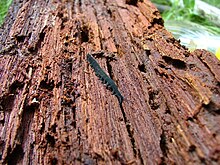Euperipatoides kanangrensis
| Euperipatoides kanangrensis | |
|---|---|

| |
| Euperipatoides kanangrensis pacing along on a eucalyptus log in which it normally resides in Australia | |
| Scientific classification | |
| Domain: | Eukaryota |
| Kingdom: | Animalia |
| Phylum: | Onychophora |
| Family: | Peripatopsidae |
| Genus: | Euperipatoides |
| Species: | E. kanangrensis |
| Binomial name | |
| Euperipatoides kanangrensis (Reid, 1996) | |
Euperipatoides kanangrensis is a species of velvet worm of the Peripatopsidae family, described in 1996 from specimens collected in Kanangra-Boyd National Park, New South Wales. This species has 15 pairs of legs in both sexes.[1] It is endemic to Australia. The embryonic development of Euperipatoides kanangrensis has been described.[2][3] This species is viviparous.[4] This species is used as model organism for the last common ancestor of the Panarthropoda. It resembles fossil Cambrian lobopodians.[5]
References
- ^ Reid, A. L. (1996). "Review of the Peripatopsidae (Onychophora) in Australia, with comments on peripatopsid relationships". Invertebrate Systematics. 10 (4): 663–936. doi:10.1071/it9960663. ISSN 1447-2600.
- ^ Eriksson, Bo Joakim; Tait, Noel N. (September 2012). "Early development in the velvet worm Euperipatoides kanangrensis Reid 1996 (Onychophora: Peripatopsidae)". Arthropod Structure & Development. 41 (5): 483–493. doi:10.1016/j.asd.2012.02.009. PMC 3437555. PMID 22430148.
- ^ Janssen, Ralf; Budd, Graham E. (October 2013). "Deciphering the onychophoran 'segmentation gene cascade': Gene expression reveals limited involvement of pair rule gene orthologs in segmentation, but a highly conserved segment polarity gene network". Developmental Biology. 382 (1): 224–234. doi:10.1016/j.ydbio.2013.07.010. PMID 23880430.
- ^ Baker, Caitlin M; Buckman-Young, Rebecca S; Costa, Cristiano S; Giribet, Gonzalo (2021-12-09). Xia, Xuhua (ed.). "Phylogenomic Analysis of Velvet Worms (Onychophora) Uncovers an Evolutionary Radiation in the Neotropics". Molecular Biology and Evolution. 38 (12): 5391–5404. doi:10.1093/molbev/msab251. ISSN 1537-1719. PMC 8662635. PMID 34427671.
- ^ Ou, Qiang; Shu, Degan; Mayer, Georg (January 2012). "Cambrian lobopodians and extant onychophorans provide new insights into early cephalization in Panarthropoda". Nature Communications. 3 (1): 1261. Bibcode:2012NatCo...3.1261O. doi:10.1038/ncomms2272. ISSN 2041-1723. PMC 3535342. PMID 23232391.
Further reading
![]() Media related to Euperipatoides kanangrensis at Wikimedia Commons
Media related to Euperipatoides kanangrensis at Wikimedia Commons
- Eriksson, B. J.; Tait, N. N. (2012). "Early development in the velvet worm Euperipatoides kanangrensis Reid 1996 (Onychophora: Peripatopsidae)". Arthropod Structure & Development. 41 (5): 483–93. doi:10.1016/j.asd.2012.02.009. PMC 3437555. PMID 22430148.
- Eriksson, B. J.; Stollewerk, A. (2010). "Expression patterns of neural genes in Euperipatoides kanangrensis suggest divergent evolution of onychophoran and euarthropod neurogenesis". Proceedings of the National Academy of Sciences. 107 (52): 22576–81. Bibcode:2010PNAS..10722576E. doi:10.1073/pnas.1008822108. PMC 3012506. PMID 21149708.
- Eriksson, B. J. (2009). "The involvement of engrailed and wingless during segmentation in the onychophoran Euperipatoides kanangrensis (Peripatopsidae: Onychophora) (Reid 1996)". Development Genes and Evolution. 219 (5): 249–64. doi:10.1007/s00427-009-0287-7. PMID 19434423. S2CID 6694566.
- Eriksson, B. J. (2005). "Expression of engrailed in the developing brain and appendages of the onychophoran Euperipatoides kanangrensis (Reid)". Journal of Experimental Zoology Part B: Molecular and Developmental Evolution. 304B (3): 220–28. doi:10.1002/jez.b.21043. PMID 15834939.
- Eriksson, B. J. (2003). "Head development in the onychophoran Euperipatoides kanangrensis with particular reference to the central nervous system" (PDF). Journal of Morphology. 255 (1): 1–23. doi:10.1002/jmor.10034. PMID 12420318. S2CID 42865895. Archived from the original (PDF) on 2015-05-29.
- Reid, A. L. (1996). "Review of the Peripatopsidae (Onychophora) in Australia, with Comments on Peripatopsid Relationships". Invertebrate Taxonomy. 10 (4): 663–936. doi:10.1071/IT9960663.
